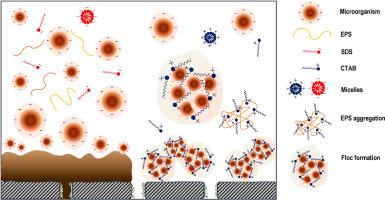在处理废弃活性污泥时补充表面活性剂对减轻膜堵塞的作用:实验和模型分析
IF 9.7
1区 环境科学与生态学
Q1 ENGINEERING, ENVIRONMENTAL
引用次数: 0
摘要
在这项研究中,研究人员将表面活性剂作为一种新型策略,用于减轻废弃活性污泥(WAS)膜过滤过程中的膜污垢。从通量变化、膜排斥和污垢机理等方面研究了使用不同表面活性剂预处理 WAS 对膜性能的影响。为确定膜堵塞机理,建立了堵塞定律的一般化形式。结果表明,低于临界胶束浓度(CMC)值的阳离子表面活性剂可改善膜性能,而阴离子和非离子表面活性剂在所有用量下都会产生负面影响。观察发现,用 300 毫克/升十六烷基三甲基溴化铵(CTAB)预处理 WAS,可将水通量从 195 升/平方米/小时(LMH)提高到 611 升/平方米/小时(LMH),并将排斥率从 93% 降低到 85%。虽然由于表面活性剂的增溶特性,CTAB 使细胞外高分子物质(EPSs)总量从 56.16 mg/L 增加到 119.6 mg/L,但总阻力却从 0.33×1010 m-1 下降到 0.11×1010 m-1。这归因于 CTAB 通过电荷中和和架桥机制诱导形成的絮状物。模型模拟结果表明,CTAB 的加入使污垢机理从滤饼模式转变为中间阻塞模式。环境风险评估显示,渗透液中表面活性剂的渗透量仅为 0.3 mg/L,对水环境的生态风险较低(风险商数为 0.5)。我们的研究结果表明,低剂量(0.1 g/L)CTAB 处理是缓解污垢和改进废水处理膜过程的一种有效方法。本文章由计算机程序翻译,如有差异,请以英文原文为准。


Performance of surfactant supplementation on alleviating membrane fouling in treatment of waste activated sludge: Experimental and modeling analyses
In this research, surfactant supplementation was investigated as a novel strategy for alleviation of membrane fouling in waste activated sludge (WAS) membrane filtration process. The effect of WAS pre-treatment with different surfactants on membrane performance were investigated in terms of flux variation, membrane rejection and fouling mechanisms. A generalization form of blocking law was developed to determine membrane fouling mechanism. According to the results, cationic surfactant below critical micelle concentration (CMC) values improved membrane performance, while anionic and non-ionic surfactant showed a negative impact at all dosages. It was observed that WAS pretreatment with 300 mg/L Cetyltrimethylammonium bromide (CTAB) could increase the water flux from 195 to 611 L/m2/h (LMH) and decrease the rejection rate from 93% to 85%, respectively. Although CTAB addition increased the total extracellular polymeric substances (EPSs) amount from 56.16 to 119.6 mg/L which was due to the surfactant solubilization property, the total resistance decreased from 0.33 × 1010 to 0.11 × 1010 m−1. This was attributed to the flock formation induced by CTAB through charge neutralization and bridging mechanism. Modeling simulation of the results indicated that CTAB addition transformed fouling mechanism from cake to intermediate-blocking model. The environmental risk assessment revealed that only 0.3 mg/L surfactant penetrated in permeate which was low ecological risk (risk quotients (RQ) < 0.5) to the aquatic environment. Our finding suggested CTAB treatment at low dosage (0.1 g/L) as a promising and efficient approach for fouling mitigation and improving membrane process for wastewater treatment.
求助全文
通过发布文献求助,成功后即可免费获取论文全文。
去求助
来源期刊

Journal of Cleaner Production
环境科学-工程:环境
CiteScore
20.40
自引率
9.00%
发文量
4720
审稿时长
111 days
期刊介绍:
The Journal of Cleaner Production is an international, transdisciplinary journal that addresses and discusses theoretical and practical Cleaner Production, Environmental, and Sustainability issues. It aims to help societies become more sustainable by focusing on the concept of 'Cleaner Production', which aims at preventing waste production and increasing efficiencies in energy, water, resources, and human capital use. The journal serves as a platform for corporations, governments, education institutions, regions, and societies to engage in discussions and research related to Cleaner Production, environmental, and sustainability practices.
 求助内容:
求助内容: 应助结果提醒方式:
应助结果提醒方式:


